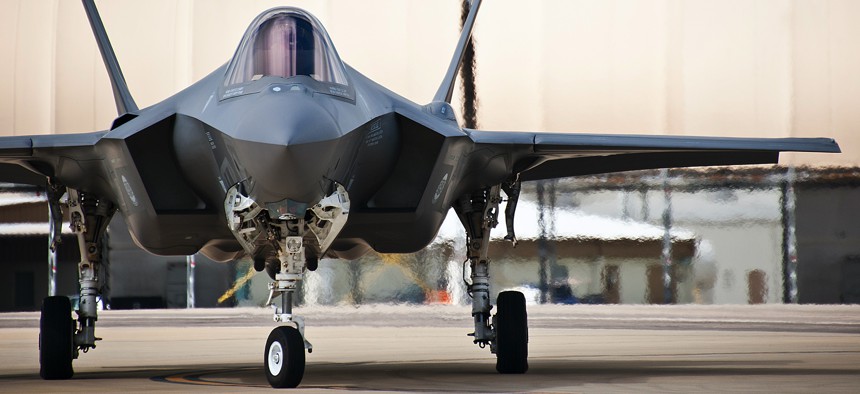TRAVIS SHARP, CHRIS BASSLER and TYLER HACKER

Each year, the U.S. defense community devotes considerable attention to individual weapons. Since 2021, for example, congressional proceedings have mentioned the F-35 aircraft more than 420 times, including in speeches and reports discussing its flight performance, economic implications, and more. The time spent appraising specific platforms is understandable given the huge investments and cutthroat politics surrounding these projects, not to mention that the budget boils everything down to line items. Yet this extensive attention is misplaced.
Modern weapons do not operate alone, but as subcomponents of battle networks or reconnaissance-strike complexes of sensors, shooters, enablers, and deciders. These “networked force packages,” as we call them, form a middle layer between individual platforms and force structure. In basic terms, a networked force package is two or more interconnected weapons that perform a military mission.
The U.S. defense community should adopt a similar approach to analyzing the operational value and cost-effectiveness of the things it buys, or proposes to buy. This approach will align weapons assessment with how the U.S. military fights. It will also further leverage an enduring advantage over China and Russia: the U.S. openness to rigorous analysis.
To its credit, platform-centric assessment can break complex problems into smaller pieces to examine trade-offs. However, it can also neglect how an individual weapon contributes to and depends on its networked force package. This shortcoming has become more damaging as technological advancements have better connected U.S. forces and expanded the potential force combinations available to military planners.
Defense thinkers have long aspired to look beyond platforms, from Gene Fisher’s “total force analysis” recommendations in the 1960s to Adm. William Owens “system-of-systems” vision of military operations in the 1990s. These ideas live on through recent technical work on kill chains, mission engineering, and campaign analysis. The Pentagon is flirting with more holistic approaches, too. In September 2021, it announced new reviews that would assess weapons investments as portfolios rather than programs. The “family of systems” approach has also infused force development initiatives such as Future Vertical Lift, Marine Littoral Regiments, mega-constellations, U.S. airpower with uncrewed complements, and future Carrier Strike Groups.
Unfortunately, this mode of thinking has not expanded much beyond specific pockets of experts. The broader U.S. defense community continues to focus heavily on either the individual platform or the force structure, neglecting the networked force package situated in between.
The networked force package approach can challenge conventional wisdom about operational and cost effectiveness. Consider two cases, one with collaborative munitions and the other with fighter aircraft.
Current weaponeering practices tend to narrowly compare the expected effects of munitions on targets without considering how networked force packages influence operational effectiveness. In an air interdiction targeting an enemy battalion tactical group, decisionmakers might judge as equally effective a GBU-53 StormBreaker glide bomb upgraded with collaborative capabilities and a GBU-12 Paveway II laser-guided bomb. After all, the two munitions produce similar effects against armored vehicles. However, the ability of the upgraded GBU-53, empowered by its network, to self-deconflict, track enemies, loiter, and reattack would allow it to destroy nine times as many vehicles per attack run while its delivery aircraft remained further from enemy air defenses. The networked force package approach clarifies these operational advantages.
Platform-centric assessment’s favored metric, cost per weapon, tends to ignore how spending on one system can avoid the need for spending on other systems. In a fighter sweep targeting enemy mobile ballistic missiles, four F-35As would cost some 50 to 70 percent less, in terms of hourly operation and support costs, than a combination of F-16s, F-15Es, and support aircraft performing the same mission. This is because the F-35A carries its own signals collection, electronic warfare, airborne warning, and local air battle management. The networked force package approach illuminates this counterintuitive aspect of cost-effectiveness.
As well, the new approach could reframe choices about ground and naval force design. For instance, networked force packages composed of precision-guided artillery units or large surface combatants with digitally tethered unmanned surface vessels may be able to generate more strike capacity at less overall cost than unguided artillery units or multiple manned surface ships, respectively.
The networked force package approach likely will face some resistance. Over the last decade, the Pentagon has gravitated away from aggregated styles of analysis, including campaign models and force structure trade-off studies. Some leaders consider them excessively cumbersome and labor intensive. But the Department need not overhaul its existing analytical enterprise to advance networked force package analysis. Starting a few pilot projects run by small teams and using ideas from outside the Pentagon’s traditional analytical approaches would suffice. The congressionally mandated PPBE Commission should endorse such a pilot program to build momentum and help decisionmakers ask the right questions.
The United States currently enjoys several advantages in its strategic competitions against China and Russia. One is the ability and willingness to use analysis to challenge assumptions, expose flaws, and consider alternatives to its own official thinking. Defense bureaucracies in authoritarian states brook such activity far less abidingly. Intellectual ferment remains a relative strength of American strategic culture. The U.S. defense community should exploit this advantage by using the networked force package approach to spur critical thinking about defense investments in the 2020s and beyond.
No comments:
Post a Comment